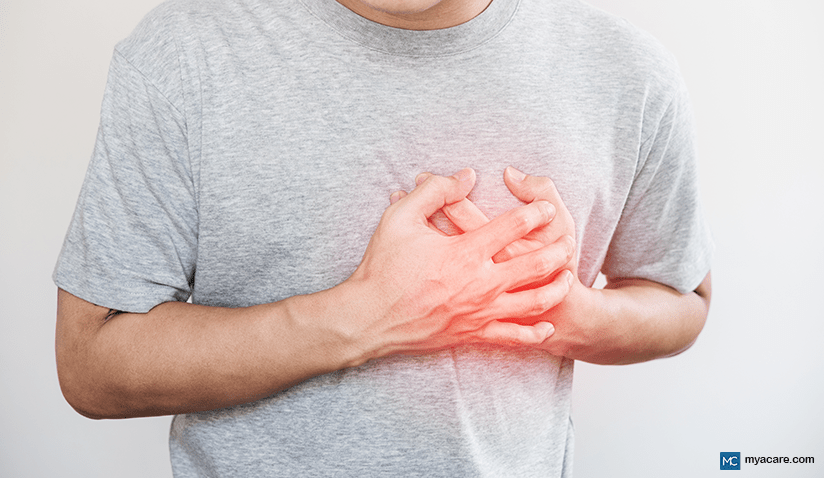REVIEW OF 20 NON-INVASIVE COSMETIC PROCEDURES TO TRY INSTEAD OF SURGERY
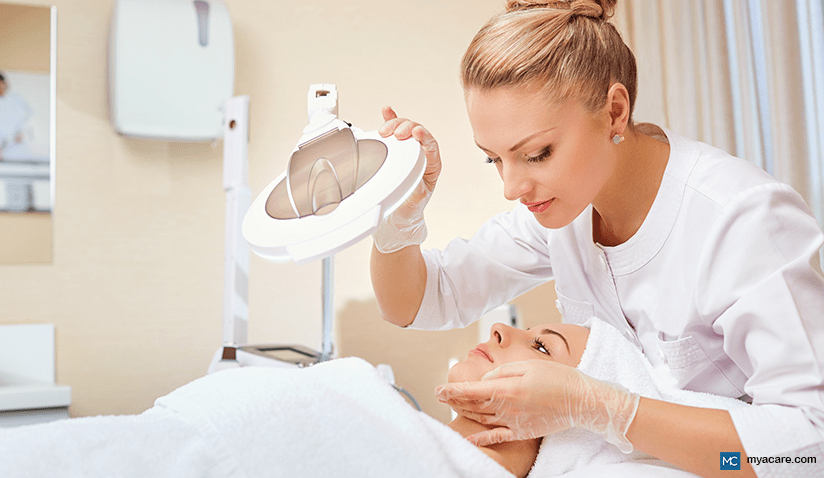
For more information on cosmetic procedures tailored to suit your needs, discuss your options with a registered cosmetic clinician. Mya Care’s extensive database offers access to some of the world’s leading healthcare professionals, including plastic surgeons, dermatologists and other cosmetic specialists.
When looking to shape your physical appearance in order to reflect and express the beauty within you, modern cosmetology has many options to choose from.
In our previous article, we described 5 invasive cosmetic procedures. In this article we discuss 20 non invasive cosmetic procedures.
20 Cosmetic Procedures - Section 1
This section covers the below dermal fillers:
1. Restylane
2. Perlane
3. Macrolane
4. uvederm
5. Profhilo
6. CosmoDerm (Human-Derived Collagen)
7. Sculptra (Poly-L-Lactic Acid)
8. Radiesse (Calcium Hydroxylapatite)
9. Bellafill (Polymethyl-Methacrylate Microspheres)
Dermal Fillers
Dermal fillers consist of a wide variety of injectable gels, each designed to flesh out and better shape the skin. Some dermal fillers double up as complete anti-aging treatments; for example, by stimulating collagen production or enhancing overall function in aged skin.
What Are Dermal Fillers Used to Treat?
Most dermal fillers are used on the face, neck and chest (décolletage) to treat minor cosmetic complaints, such as wrinkles and saggy skin. However, they can technically be used to treat skin in any area and have been successfully used as non-surgical alternatives to implants and other invasive cosmetic corrections. Fillers are also often used to fine tune surgical corrections.
Dermal fillers each possess a unique formula, designed to target either one or multiple cosmetic concerns. As a rule of thumb, lighter fillers are used on superficial layers of the skin for lesser cosmetic defects; while denser fillers are used to fill deeper layers of the skin in order to augment and enhance overall shape.
Your cosmetic physician will select an appropriate filler or combination of treatments to ensure the best result.
NOTE: Laser treatment, chemical peels or any other aesthetic procedure that induces large amounts of inflammation may act to degrade the filler material inside the skin, reducing the duration of the filler’s effectiveness.
General Benefits of Dermal Fillers
- Adds volume to sagging skin
- Enhances shape and contour
- Reduces the appearance of wrinkles and lines
- Can act in place of a facelift or similar surgical procedure
Potential Dermal Filler Side Effects
Transient immune activation is a normal occurrence while the body adjusts to the filler material. Side effects typically last only for a few days and may include mild tenderness, swelling and redness in the treated area.
Cosmetic professionals are trained to prevent severe side effects through proper sterilization and injection techniques. As a result, severe complications are highly unlikely[34], however no treatment is free of potential risk.
Examples of filler complications include:
- Severe adverse immune reactions (abnormal swelling, lump formation, pain, redness, rashes, etc)
- Post-procedural infections
- Loss of blood flow to the treated area resulting in necrosis[35]
- Loss of immune tolerance and increased sensitivity
- Scarring
- Filler migration to distant organs and tissues (a common issue with permanent fillers[36])
- Abscess formation[37]
- Degradable products that do not release or consist of proteins, viruses and other potentially hazardous materials are associated with a much lower risk of post-procedural complications[38]. Stabilized hyaluronic acid fillers are a prime example.
Common Dermal Filler Contraindications
It is best to discuss first with your healthcare practitioner whether opting for a dermal filler treatment is contraindicated in your case, especially if you are on prescription drugs.
Dermal fillers are contraindicated in general for:
- Allergic or sensitive individuals
- Those with chronic infections, especially herpes simplex, staphylococcus[39] or streptococcus
- Immune compromised individuals (patients with autoimmune, cancer, HIV, etc)
- People with hypertension, high cholesterol or heart disease
Hyaluronic Acid-Based Dermal Fillers
Hyaluronic acid (HA) is a component of all connective tissue and is found in some of the largest quantities in skin, where it contributes to allowing for the skin to retain its moisture and elasticity. For cosmetic use, HA is extracted from either animal tissue or synthesized via bacteria in a lab.[40]
Different molecular weights of HA (high and low) are cross-linked and combined to create skin-injectable gels, that perfectly mimic skin texture, density and elasticity.[41] Additional chemicals are usually required to achieve cross-linking.
Due to its role in skin function, HA is also used to create anti-aging fillers that rehydrate the skin, promote collagen and elastin formation, and improve overall complexion.
Skin Benefits of Hyaluronic Acid
- Improves skin moisture retention and elasticity
- Stimulates collagen production
- Ensures treated skin looks and responds as though young
- Degrades in under 2 years
A few widely available hyaluronic acid fillers include Restyane, Juvederm, and Profhilo.
1. Restylane
What it is
Restylane is an HA-based filler that is intended for treating superficial defects while simultaneously enhancing skin elasticity, moisture retention and vitality.
How it works
Low weight HA droplets in Restylane are evenly injected into the surface layers of the skin to enhance overall hydration and reduce skin dryness. It can also be injected into the mid dermis for delicate cosmetic fixes such as lip enhancement and smoothing out fine wrinkles.
Best for…
- Fine lines
- Mild to moderate wrinkles
- Forehead furrows
- Aesthetic restoration of the decolletage, hands and neck[42]
- Delicate facial touch ups
- Periorbital defects (around the eyes)
- Lip enhancement
- Skin-boosting and hydration
Duration
Temporary – up to 6 months.
Safety & Tolerability
Restylane is safe and effective with minimal risk of side effects.
2. Perlane
What it is
Perlane is identical in formula to Restylane, with the exception of carrying larger HA molecules and being more suited to working on larger cosmetic concerns.
How it works
Medium-sized HA microbeads are injected into the deeper layers of the skin to volumize, moisturize and reinstate healthy collagen production. Unlike Restylane, Perlane is designed for deep wrinkles, furrows and moderate facial touch-ups.
Best for…
- Deep wrinkles
- Nasolabial folds
- Nose and jawline corrections[43]
- Treating fine lines around the nose and mouth
- Cheek volumizing and contouring
- Periocular region (around the eyes)[44]
Duration
Temporary – lasts 6-9 months on average.[45]
Safety & Tolerability
Due to the higher weight molecules and trace amounts of bacterial proteins[46] present in Perlane, there may be a higher risk of adverse immune reactions. Your physician ought to test for any allergy prior to treatment.
Perlane is associated with a low (6%) risk of developing hyperpigmentation, which tends to resolve after several weeks.
3. Macrolane
What it is
Macrolane was designed to enhance overall body shape through macro contour definition. Created by Q-Med like Perlane and Restylane, Macrolane is a bulking HA filler gel with the largest micro components.
How it works
The product can be applied in all large skin areas of the body to do away with large folds, enhance bodily symmetry and give the skin a hydrating boost. Most commonly used for cosmetically sculpting the buttocks, thighs, arms, torso and shoulders.
Best for…
- Full body skin volumizing (buttocks, thighs, arms, etc)
- Deep folds
- Aesthetic treatment for cellulite or muscle wasting
- Equalizing body symmetry
Duration
Temporary – lasts up to 12 months.
Can potentially be made semi-permanent with multiple treatments.
Safety & Tolerability
Macrolane interferes with breast cancer screening tests and is therefore not recommended for breast enhancement procedures.[47] For this reason, macrolane has not been approved for breast enlargement by the US FDA or the relevant Canadian cosmetic boards and is entirely banned for this purpose in Europe. Macrolane should also never be used for penis enlargement procedures.[48]
4. Juvederm
What it is
Juvederm is a suite of HA-based filler gels that boast some of the highest concentrations of HA. Effects of Juvederm products tend to last longer than other HA fillers on average and tend to be much gentler on the skin.
How it works
Juvederm products incorporate a novel HA cross-linking process (Hylacross) that allows for a smoother, softer overall experience with very fine HA particles. Treatment allows for optimal rehydration of aging skin while simultaneously adding volume and enhancing overall aesthetic appeal.[49]
Best for…
- Moderate to deep wrinkles and folds
- Nasolabial folds
- Lip and chin enhancement
- Subtle cheek volumization
- Gentle facial contouring
Duration
Temporary – lasts 9-12 months on average.[50]
Safety & Tolerability
On average, less juvederm is required compared to other fillers to enhance skin aesthetic and therefore there is a slight less risk associated with treatment. Tolerability is comparable to other HA fillers.[51]
5. Profhilo
What it is
Profhilo is a 50-50 combo of high and low weight HA, with the lower weight portion creating a matrix that is suspended in the higher weight portion.
How it works
The gel is mostly used as a skin-boosting treatment to rehydrate skin and improve collagen production.
Profhilo mimic’s skin tissue effectively, lowers the chance of adverse reactions and can also be injected to fill out and better shape saggy or aging skin in more sensitive individuals. [52]
Best for…
- Overall skin rejuvenation (face and body)
- Rehydration
- Face fullness
- Firming and toning of skin
- Static wrinkles
- Treating scar damage
- Aging skin (skin muscle breakdown)
Duration
Temporary – lasts up to 6 months.
Multiple applications may extend the effects and make the treatment semi-permanent.
Semipermanent for large bodily areas – lasts between 1-2 years on average.[53]
Safety & Tolerability
High- and low- weight HA have each been shown to provoke opposing immune reactions, with the former inducing inflammation and the latter enhancing its resolution[54]. Profhilo is therefore likely to be one of the safest HA dermal fillers as it maintains equal proportions of high and low weight molecules.
Clinical trials have supported these findings, revealing that profhilo treatments are well-tolerated on average with adverse events being very rare[55].
Other Dermal Fillers
6. CosmoDerm (Human-Derived Collagen)
What it is
CosmoDerm I and II are injectable filler gels made from lab-engineered human collagen, which tends to be more hypoallergenic than bovine collagen.
How it works
Collagen breaks down at a faster rate than it replenishes in aging skin, resulting in less definition, a saggy complexion and wrinkle formation. CosmoDerm injections provide the skin with enough collagen to replenish its natural supply and therefore promote better functioning skin with increased vitality.
While it does fill skin, the effect is minimal and the product is often used in combination with other fillers to achieve the desired effect.[56]
CosmoDerm complements HA fillers the most as it supplies the skin with an immediate source of collagen while HA is capable of volumizing skin, improving moisture retention and stimulating long-term collagen formation in the skin.
Benefits
- Hypoallergenic
- Provides an immediate source of collagen to the skin
- Improves efficacy of other filler treatments
Best for…
- Fine lines and wrinkles
- Minor cosmetic fixes
- Restoring an aging face or aged skin
- Enhancing skin collagen content
- Those who need collagen therapy and are allergic to bovine products
Duration
Temporary or semi-permanent with multiple applications – effects last 10-18 months on average.
Safety & Tolerability
Treatment with collagen demands pre-screening for allergy or sensitivity to the material. Human-derived collagen is generally better tolerated than bovine-derived collagen.
Complications pertaining to collagen-based fillers are worse on average than those pertaining to HA treatment.
7. Sculptra (Poly-L-Lactic Acid)
What it is
Sculptra and Sculptra Aesthetic are fillers made from Poly-L-Lactic Acid (PLLA), which is a synthetically produced alpha-hydroxy acid. Alpha-hydroxy acids are used in the cosmetics industry for enhancing skin function and firmness[57].
These PLLA dermal fillers were initially created as facial cosmetic fixes for the severe muscle wasting associated with HIV and anti-retroviral use. Subsequent to their arrival, these products have also been approved for nasolabial folds, deep wrinkles and facial contouring.[58]
How it works
Sculptra and other PLLA fillers stimulate healthy skin collagen production[59], enhancing the appearance and integrity of sunken skin over time. During the process, PLLA breaks down into water and carbon dioxide, making it a gentler procedure that gives rise to a more natural result.
Benefits
- Stimulates collagen and elastin formation
- Biodegrades into natural by-products (water and CO2)
Best for…
- Restoring volume to limp facial skin
- Shaping larger areas of the face
- Correcting moderate to severe wrinkles, crow’s feet and smile lines
- Nasolabial folds
- Deep scarring
- Plumping thin lips
- Sensitive, aged or fat-deficient skin
Duration
Semi-permanent – lasts up to 2 years
The effects can take a few weeks to a few months to become noticeable.
Safety & Tolerability
PLLA injections are usually well-tolerated when used for the right indications and are subjecting the consumer to the same general risk for adverse reactions as other dermal fillers.[60]
8. Radiesse (Calcium Hydroxylapatite)
What it is
Radiesse is a filler made from calcium hydroxylapatite (CaHa) that is designed to fill sunken skin and do away with deep-seated wrinkles and frown lines. It is viewed like an injectable implant. [61]
How it works
CaHa is a natural mineral component of bone tissue and known in the cosmetic industry for stimulating skin collagen formation as it degrades over time under the skin’s surface. CaHa is often used to enhance the shape of the aging face.
Benefits
- Treatment takes up to 15 minutes with immediate improvement
- Stimulates skin collagen production
- Improves skin elasticity and volume[62]
- Lasts for over a year
Best for…
- Marionette and frown lines
- Deep nasolabial folds
- Severe scarring
- Enhance the shape and volume in wasted facial skin and hands[63]
Duration
Semi-permanent – lasts 12-18 months on average.
Safety & Tolerability
The calcium and phosphorus ions in the CaHa that make up Radiesse mimic the inorganic components of teeth and bone. The biocompatibility of the substance substantially lowers risk of side effects and treatment is generally well-tolerated.
9. Bellafill (Polymethyl-Methacrylate Microspheres)
What it is
Bellafill is a dermal filler that consists of a combination of polymethyl-methacrylate microspheres (PMMA) and bovine collagen. [64] PMMA has been used as a main ingredient in implants and thus, Bellafill could be viewed as a liquid implant and applied as such.
How it works
PMMA stimulates the production of collagen at the site of injection and makes an effective filler treatment for larger wrinkles, lines and unsightly skin depressions, as seen in severe atrophic scarring. It is the go-to treatment for individuals wanting to make long-term cosmetic corrections to deep wrinkles, scars and dimples.
The bovine collagen provides immediate improvement while the skin is in process.
Bellafill and other PMMA products usually require multiple injections over a few months to achieve the desired effect. It’s important that the process is slow in order to achieve a perfect result.
PMMA stands a chance of being seen while underneath the skin. Proper injection methods can largely mitigate the risk involved, making it important to opt for a credible cosmetic specialist.[65]
Benefits
- Enhances collagen formation over 5 years
- Fills out any larger skin dents and wrinkles
- Serves as a skin resurfacing alternative for atrophic scarring
Best for…
- Nasolabial folds
- Smile lines
- Severe scarring
- Deep wrinkles, folds and furrows
- Lip volumizer
- Sagging skin associated with severe muscle wasting
- Helps enhance implants for breasts and buttocks[66]
Duration
Semi-Permanent - up to 5 years
Safety & Tolerability
This treatment should never be used for lip enhancement, near the eyes or to fill fine lines and wrinkles.
PMMA is generally well tolerated if applied in the best indicated areas; however bovine collagen is a known allergen. Your physician is obligated to test you for an allergy prior to administering any form of bovine collagen.
20 Cosmetic Procedures - Section 2
This section of the cosmetic procedure review covers the following non-invasive aesthetic treatments:
10. Dermabrasion
11. Microdermabrasion
12. Light Chemical Peels
13. Heavy Chemical Peels
14. Laser Skin Resurfacing
15. Botox
16. Platelet-Rich Plasma Injections (PRP)
17. Lipogems Stem Cell Therapy
18. Sclerotherapy
19. Laser Hair and Blemish Removal
20. Ultrasound
Skin Abrasion & Resurfacing Techniques
New skin turnover is a large part of what makes our complexion look radiant and youthful. As we age, the skin’s ability to regenerate on a constant basis begins to decline. Between carrying too much dead tissue and not being able to produce enough new tissue, the skin’s surface loses its smoothness, inheriting wrinkles and other blemishes instead.
Those who were skin-wise throughout their youth will have kept up with daily exfoliation. For the rest of us, a skin resurfacing treatment could be a good way to make up for lost time!
Skin resurfacing treatments all use some form of skin abrasion to break down dead tissue, promoting exfoliation, regeneration and new skin turnover.
Potential Side Effects of Skin Resurfacing Treatments
Taking off the outer layers of skin tends to have minimal complications compared to the likes of surgery. Of the complications one can experience, the most common include:
- Hyperpigmentation or hypopigmentation
- Aggressive scarring
- Post-procedural infections or outbreaks
Generally the treatments that take off more layers of skin are more aggressive and less well-tolerated than the lighter treatment options.
Contraindications of Skin Abrasion and Resurfacing
Those with auto-immune skin diseases or thin skin that has lost its strength should not opt for skin resurfacing. Treatment may also be contraindicated for those with sensitive or dark skin as it may result in excessive irritation, hyperpigmentation or complete loss of pigmentation.
10. Dermabrasion
What it is
Dermabrasion is the practice of using a mechanical device to grind down the superficial layers of skin in order to give way to the new unblemished skin underneath.
How it works
A device known as a dermabrader is placed on the treatment area, consisting of a crystalline or other similar abrasive surface. The average device generates rotational speeds of 18000-35000 revolutions per minute, making short work of the damaged outer layers of skin.[67]
Anesthetic is often a requirement for dermabrasion and a recovery period of a few days to weeks can be expected after treatment.
Benefits
- Creates an instantly smooth skin tone and texture
- Encourages skin regeneration
- Penetrates to the deeper layers of skin
Best for…
- Deep wrinkles and scars
- Reducing the appearance of crow’s feet and lip lines
- Removing damaged skin and scar tissue
Duration
Permanent – recovery period lasts for 2-3months on average.
Safety & Tolerability
When used correctly, dermabrasion is generally regarded as safe with few side effects. Its indications are minimal however and microdermabrasion is usually the preferred abrasion technique.
Dermabrasion is best utilized for small applications, such as getting rid of a deep seated scar. If used in larger applications, such as resurfacing the entire face, then it should be done in combination with other surgical techniques to minimize the recovery side effects and possibility of complication.[68]
11. Microdermabrasion
What it is
Microdermabrasion follows the same concept as dermabrasion yet the device used is finer and designed to remove only the outer most layer of skin.[69]
How it works
Very fine abrasive crystals are brushed against the skin using a handheld vacuum device. The device suctions up exfoliated skin, dead tissue and any excess crystal debris. The result is a smoother complexion and a reduction in the visible signs of aging.
Benefits
- Safe for all skin types
- Promotes gentle and even growth of new skin
- Less aggressive than dermabrasion
- Lessens the visible signs of skin aging and sun damage
- Improves skin water retention
Best for…
- Sun spots and blemishes
- Fine lines and wrinkles
- Little scars and burns
- Renewing damaged skin and dead tissue
- Smoothing the tone and texture of skin
Duration
Permanent – recovery time lasts a few days to a week on average.
Safety & Tolerability
Complications of microdermabrasion are rare and the treatment is safe for most individuals[70].
Chemical Peels
A chemical peel is typically a chemical agent that an aesthetician applies to an area of skin in order to remove the damaged top layers. [71] The procedure can also be referred to as chemexfoliation.
The chemical solution exfoliates the skin and is generally applied to the face, hands or neck. The treatment targets all the superficial wrinkles and blemishes that reside in the outer layers of the skin by permanently removing (chemically peeling) these layers. Through the process of skin regrowth, the skin’s tone and vitality receives a natural boost and after some recovery, the net effect is a smoother complexion. Chemical peels do not prevent future blemishes and wrinkles from forming.
There are heavier and lighter chemical peels, with lighter peels removing fewer layers of skin at a time. Fewer complications are seen in those who opt for light chemical peels, however more treatment sessions may be needed to achieve the desired results[72].
12. Light Chemical Peels
Light chemical peel agents include: alpha and beta hydroxy acids (fruit enzymes, malic acid, lactic acid, citric acid, glycolic acid and salicylic acid) or low concentrations of trichloroacetic acid (10-20%). Medium peels tend to be a combination of trichloroacetic acid (up to 35%) and alpha-hydroxy acids.[73]
Benefits
- Gentle exfoliation
- Promotes skin regeneration
- Supports natural skin function
- Moisturizes skin
- Chelates and removes localized toxins[74]
- Hypoallergenic
Best for…
- Sensitive skin
- Fine wrinkles
- Little skin irregularities
- Dry flaky skin
- Some scars and burn wounds
- Acne or acne scarring
- Lightening the appearance of sun spots and blemishes
Duration
Permanent – recovery time lasts a few days to a week on average.
Safety & Tolerability
Alpha-hydroxy acids may temporarily cause the skin to become sensitive to sunlight and burn more easily. The effects are dose-dependent.[75] In this respect, those who are susceptible to sunburn or who are at a higher risk for skin cancer should do smaller applications and take care to avoid sunlight until the skin has fully recovered.
13. Heavy Chemical Peels
Heavy chemical peels include: phenol peels, croton oils and high concentrations of trichloroacetic acid (<50%[76]) which will slough off many layers of skin in one shot. Heavy peels are best used for smaller applications to get rid of deep skin defects in the surface layers.
Benefits
- Radical exfoliation and skin resurfacing
- Removes toxins from deeper layers of the skin
- Can tone and tighten skin in some cases
- Cost effective
Best for…
- Deep wrinkles
- Superficial skin damage
- Severe scars and burn wounds
- Removing sun spots and blemishes
- Lightening complexion
Duration
Permanent – recovery period lasts for 2-3months on average.
Safety & Tolerability
Light chemical peels are far better tolerated than heavy chemical peels, which demand a far longer recovery time post treatment to allow for the skin to regenerate. Nutrients and rehydration therapies may enhance treatment.
14. Laser Skin Resurfacing (Ablative Lasers)
What it is
As the name suggests, laser skin resurfacing refers to a cosmetic procedure in which a medical laser device is used to smooth out any irregularities on the skin’s surface[77]. Lasers are capable of reducing the appearance of wrinkles, scarring and other blemishes while simultaneously stimulating skin function, tone and vitality.
Ablative lasers are laser devices that work on the top layers of the skin, tend to be more aggressive than their non-ablative counterparts and are employed for skin resurfacing more often on average for this reason. Treatment quickly (and accurately) obliterates any faulty tissue in the surface layers of the skin and encourages new growth, with the end result looking “good as new.”
How it works
Medical lasers are devices that emit pulses of concentrated light into a target tissue. Depending on the concentration of photons and intensity of treatment, light energy can exert a wide variety of different effects in our cells. [78]
Ablative cosmetic lasers typically target superficial layers of the skin, delivering high bursts of energy that heat up and break down faulty skin tissue through targeting water molecules or other suitable micro-media[79]. The most common ablative lasers take off the top layers of skin for the purpose of creating a smooth, wrinkle-free surface[80]. In response to this breakdown, the skin is stimulated to promptly regrow the entire area from scratch. A recovery period is required before the results are apparent.
Targeting slightly deeper layers of the skin with an ablative laser can be useful for obliterating moles, blemishes, tattoos, wrinkles, scars and more.
Benefits
- Creates a smooth, flawless skin texture
- Renews areas of skin
- Can lighten skin and hair
- Tightens and tones loose skin
Best for…
- Obliterating wrinkles and scars[81]
- Cosmetic fix for warts, liver spots, sun damage and birth marks
- Tightening moderately loose skin
- Stimulating collagen production and skin repair
- Tattoo removal
- Cosmetic treatment of severe acne
Duration
Permanent – recovery can take anywhere from a few weeks to 3 months on average and depends on the treatment used.
Ablative laser resurfacing does not prevent the formation of new wrinkles, acne or other blemishes in future.
Safety & Tolerability
It is normal for the skin to become red and inflamed for a few weeks after the treatment until the skin has healed. If looked after properly, complications are minimal. Additionally, PRP used in combination with ablative laser therapy has been shown to speed the resultant healing process.[82]
Fractionated lasers are better tolerated and more commonly used than their non-fractionated counterparts. An ND:YAG laser was shown to yield the lowest rate of pigmentation loss amongst study participants.[83]
Nobody should ever look a laser beam head on as it may result in permanent blindness.
Potential Side Effects
The most common side effect of ablative laser therapy is hyperpigmentation in those who tan very well or loss of pigmentation which is more noticeable in those with darker skin. Avoiding sunlight for 2 weeks prior to treatment may help lessen the risk of complications.
Other side effects could include:
- Burn marks and scars
- Infections such as staphylococcus, streptococcus or herpes viral outbreaks[84]
- Hypersensitivity to light
Contraindications
Those with nutritional deficiencies, suppressed immunity, issues with regeneration, or auto-immune skin conditions[85] should not opt for ablative laser therapy. Non-ablative laser therapy is a safer option for these candidates.
Other Non-Invasive Cosmetic Treatments
Many of the following cosmetic procedures are used as complementary treatments to enhance the aesthetic effectiveness of other procedures.
15. Botox
What it is
Botox is a treatment in which a bacterial toxin (Botulinum Toxin A) is injected into facial muscle tissue in order to induce temporary paralysis that contributes to reducing the appearance of wrinkles.
How it works
Botox consists of a neuro-toxic substance that disrupts muscle contraction, resulting in temporary mild paralysis or muscle weakness. When injected into specific sites on the face, the reduced movement of facial muscles helps to treat the appearance of dynamic wrinkles (wrinkles that are visible when we smile, frown or use our facial muscles).
Benefits
- Complements dermal filler procedures
- Arrests the movement of muscles that contribute to wrinkle formation
Best for…
- Dynamic wrinkles (between the eyebrows, on the forehead, etc)
- Forehead furrows
- Smile or frown lines
- Periorbital area (around the eyes)
- Fine lines around the mouth and chin
NOTE: Botox only treats lines that occur as a result of muscle movement[86].
Duration
Temporary – effects last 3-6 months on average.
Can be made semi-permanent with multiple treatments.
Safety & Tolerability
Few clinical complications are observed from receiving Botox injections and it is generally regarded as safe.[87] Risk of adverse events increase with long-term botox use.
Potential Side Effects
Transient headaches are the most common symptom post botox administration, as well as mild immune reactions as a result of the injection (mild pain, swelling, bruising, etc).
Other side effects include[88]:
- Nausea or an upset stomach
- Weakness or paralysis in nearby muscle tissue
- Heart arrhythmia
- Facial numbness
- Spatial disorientation
Contraindications
Botox is contraindicated in the following cases[89]:
- Active infection at the target site
- Sensitivity to botulinum toxins or any other part of the product
- Acetylcholine deficiency or tobacco withdrawal
- Certain neuromuscular diseases
16. Platelet-Rich Plasma Injections
What it is
Platelet-Rich Plasma (PRP) injections consist of concentrated blood platelets that are extracted from the recipients own blood. PRP was used to treat athletic injuries with great success before making its way into cosmetic medicine as a regenerative skin booster[90].
It is a fairly new treatment and there is limited evidence to support its efficacy[91], in spite of the fact that it is well-tolerated.
How it works
Cosmetic PRP injections stimulate the growth and spread of new skin tissue by offering an abundance of growth factors, which are proteins that are required for skin proliferation and wound repair[92]. PRP can help to enhance the result of other cosmetic treatments as it lowers inflammation and improves skin vitality, tone and function.
Some evidence reveals that combining PRP with other treatments helps to reduce pain and severity of transient symptoms, but more research is required to confirm these benefits. [93]
PRP is also used to improve hair growth in those with alopecia, with varying results.
Benefits
- Enhances collagen production[94]
- Promotes blood vessel growth and overall skin regeneration[95]
- Lowers inflammation in treated area
- May lower pain experienced during other cosmetic procedures when administered in tandem
Little to no risk of side effects
Best for…
- Stimulating wound healing in damaged areas of skin
- Fine wrinkles and subtle lines
- Reducing the appearance of scarring
- Enhancing skin vitality and function
- Improving skin tone
- Enriching other cosmetic treatments[96]
Duration
Semi-permanent – can last up to 18 months.
Safety & Tolerability
PRP is very safe and as well tolerated as your own blood cells are to the rest of your body. For most of us, that means there is virtually no risk for opting for PRP treatment.[97]
Potential Side Effects
Side effects tend to be transient and are more related to the technique, needle size and competence of the person administering the injection.
Contraindications
PRP is contraindicated in the following cases[98]:
- Fighting an active infection
- Taking blood thinning medications, alcohol or NSAIDS
- Using corticosteroids
- History of anemia, liver disease, cancer or other chronic illnesses
- Allergies to lidocaine, bovine thrombin, bupivacaine HCL or any other ingredient the physician may add during the preparation process
- Low blood, blood platelet, hemoglobin or fibrinogen count
17. Lipogems Stem Cell Treatment
What it is
Stem cells are non-specialized cells that form part of the body’s innate ability to regenerate and grow new tissue. When a stem cell specializes, it can potentially turn into any other type of cell in the body.[99]
Fat grafting is the most common cosmetic stem cell therapy, as fat serves as a natural stem cell reservoir and is usually easy to acquire from the recipient. Lipogems is an injectable stem cell product made from a special preparation of purified fat which is fast becoming an attractive add-on during cosmetic treatment.[100]
How it works
When applied to damaged skin, stem cells theoretically have the potential to renew the area by specializing into healthy new skin cells. Stem cells are currently being used to support better outcomes in cosmetic surgery in the form of fat implants.
Benefits
- May enhance dermal filler longevity and cosmetic effect[101]
- Promotes skin repair and regeneration
- Complements collagen injections[102]
- May improve results of cosmetic surgery, fat implants and dermal fillers[103]
Lowers inflammation[104]
Best for…
- Damaged skin
- Scarring
- Aged skin
- Enhancing cosmetic treatment
Duration
Temporary – effects can last up to one year.[105]
Safety & Tolerability
It is best to have stem cells harvested from the fat of the recipient as using donor material stands the risk of being contaminated with viral particles.
Stem cell treatment using one’s own grafted fat is otherwise generally regarded as safe and well tolerated on average.[106]
Potential Side Effects
The potential side effects associated with stem cell therapy are the same as any dermal filler or other injectable therapy.
Severe complications of stem cell therapy include:
- Heightened risk of tumor formation in prone individuals
- Adverse immune reactions
- Viral infection
Contraindications
Stem cell therapies are still highly experimental and should be approached with caution[107].
Since not enough is known about stem cells and the current evidence points to conflicting results, it is best to discuss stem cell therapy with your healthcare provider before opting to include it in your next skin booster shot.
18. Sclerotherapy for Spider Veins
What it is
Sclerotherapy is an injectable cosmetic treatment for spider veins. After a few treatments, the spider veins completely disappear from sight.
How it works
A sclerosing solution is injected into the vein that irritates and hardens it off over time, closing the vein[108] and causing it to collapse from view. [109] Common sclerosing agents used include sodium tetradecyl sulfate (STS)[110], polidocanol and chromated glycerin[111] (in order from most to least potent). The dermatologist will select the treatment appropriate to the appearance and size of the spider vein.
Benefits
- Seals off spider veins
- Reduces the risk of developing varicose veins in the treatment area
Best for…
- Lessening the appearance of spider veins
Duration
Permanent – recovery period lasts for 2-6 weeks on average.
Safety & Tolerability
The average complication rate for sclerotherapy is incredibly low (0.22% according to a review of the data[112]), making it one of the safest cosmetic procedures one could opt for.
Potential Side Effects
Of the low percentage of people who experience complications, side effects include:
- Excessive bruising
- Hyperpigmentation
Treatment is generally safe and these side effects are rare. Ultrasound may enhance the results.[113]
Contraindications
Most individuals can opt for sclerotherapy, with the exception of allergic individuals, pregnant mothers, those with active infections or patients with deep vein thrombosis.[114]
19. Laser Hair & Blemish Removal (Non-Ablative Lasers)
What it is
Various medical laser devices exist that target specific sites of the skin for a variety of purposes, such as hair, blemish and spider vein removal.
How it works
Pulses of low-level laser light are sent through the skin, which can lessen the appearance of blemishes or prevent the growth of unsightly hair. Lasers can also be used to obliterate spider veins[115], depending on the wavelength and frequency used.
The most commonly employed lasers heat up water droplets or other target molecules inside the cell, which then causes the cell to generate more energy and kick starts various processes, such as cellular repair, skin regeneration or blemish destruction, depending on the purpose of the treatment.
Benefits
- Improves overall complexion
- Tones skin
- Nukes spider veins[116] and unwanted blemishes
Best for…
- Reducing the appearance of spider veins and scars
- Fine lines and wrinkles
- Unwanted facial hair or unsightly patches
- Lightening and removing blemishes such as birth marks or beauty spots[117]
Duration
Permanent – recovery time can vary from a few days to a few weeks, depending on the treatment.
Safety & Tolerability
Risk of complication is typically low for non-ablative laser treatment and outcomes are good on average.
Potential Side Effects
A brief recovery period can be expected for a few days to weeks after treatment. Your cosmetic specialist will choose the laser therapy that is most appropriate for your skin type and take the necessary precautions to prevent unintended side effects and complications.
Side effects of laser treatments may include:
- Severe pain and burning[118]
- Blistering
- Scarring
- Hyper or hypopigmentation
- Blindness (if laser is looked at head on)
Contraindications
Laser therapy is contraindicated for individuals with an autoimmune skin condition, who are prone to skin infections or who have skin that is highly sensitive to light.[119]
20. Ultrasound
What it is
Ultrasound devices channel ultrasound into the deeper layers of the skin, allowing it to break down damaged tissue and promote healthy collagen production for tighter skin.[120] It can be used for a few unique applications from toning the skin to obliterating deep scars.
How it works
The device focuses waves of ultrasound energy into the skin, heating it up and destroying faulty tissue. Ultrasound is less intensive than laser therapy and penetrates deeper layers of the skin, resulting in less visible side effects and complications. Results can typically be seen 3 months after the final treatment.[121]
Benefits
- Speeds wound healing in the treated area
- Reduces pain through lowering swelling
- Softens scar tissue and lessens the appearance of scarring[122]
- Breaks down muscle stiffness like a hands-free massage
- Lifts and tightens the skin
Best for…
- Scarring
- Certain unsightly lumps (including implant complications)
- Sensitive individuals
- Natural facial contouring through enhanced collagen production
- Lifting saggy skin in the neck, chin and brow
- Enhancing treatment efficacy of scar removal procedures, fillers[123] and botox[124]
- Helps lower the risk of capsular contracture after receiving breast implants[125]
Duration
Temporary or permanent, depending on the aim of treatment.
Ultrasound obliterates scar tissue, however the results for lifting and tightening skin may not last long and more sessions will be required to extend the effect.
Safety & Tolerability
Complications of ultrasound are rare and those who opt for the therapy can go home after without any down time between treatment sessions.
Potential Side Effects
Very rare side effects include temporary bruising or numbness and tend to resolve in a few days.
Contraindications
Ultrasound is not indicated for use on the eyes[126] or where it can reach the brain and may cause harm in these areas.
Summary
The following table contains an overview of 20 different cosmetic procedures discussed in the article above. Remember only your doctor can guide you on what is the best cosmetic procedure for you, and this article only provides a list of options.
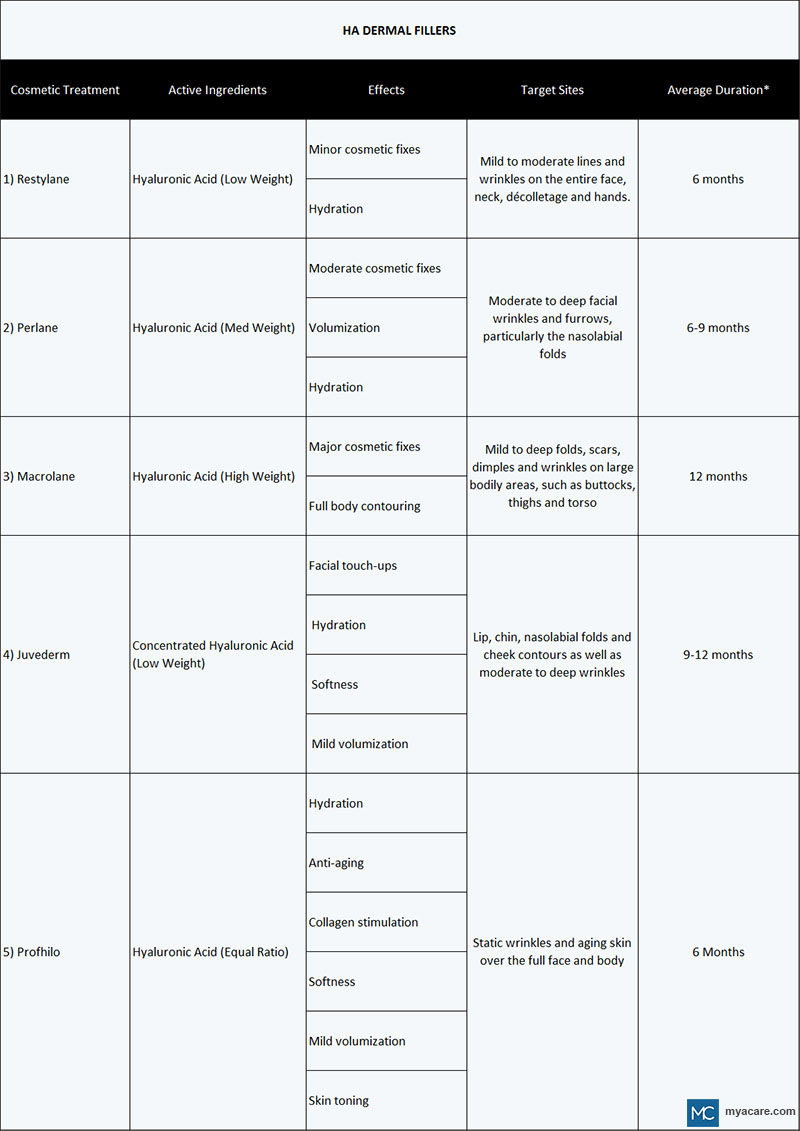
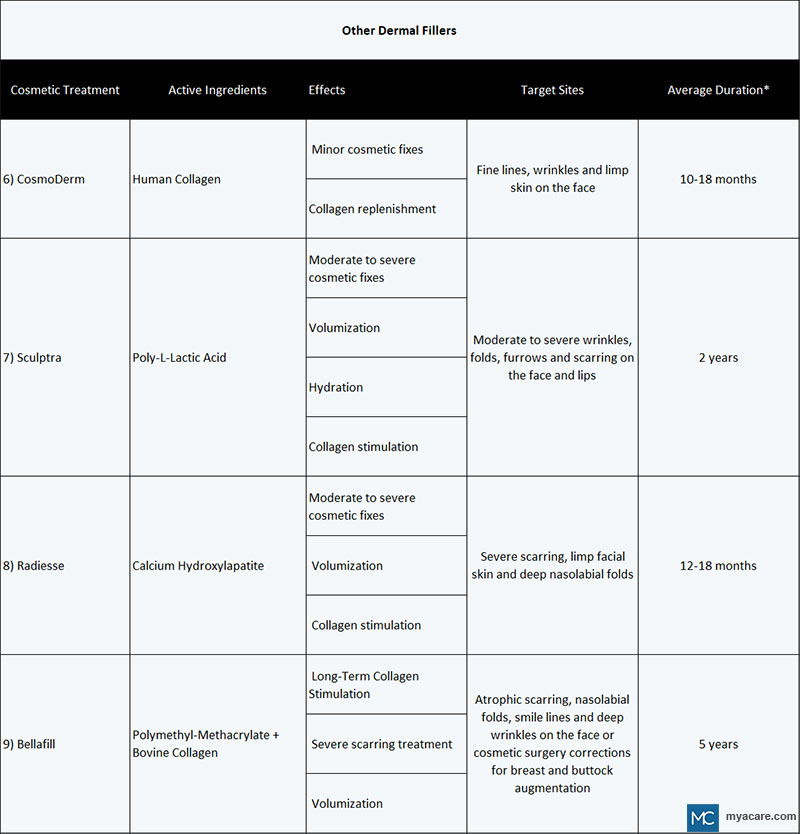
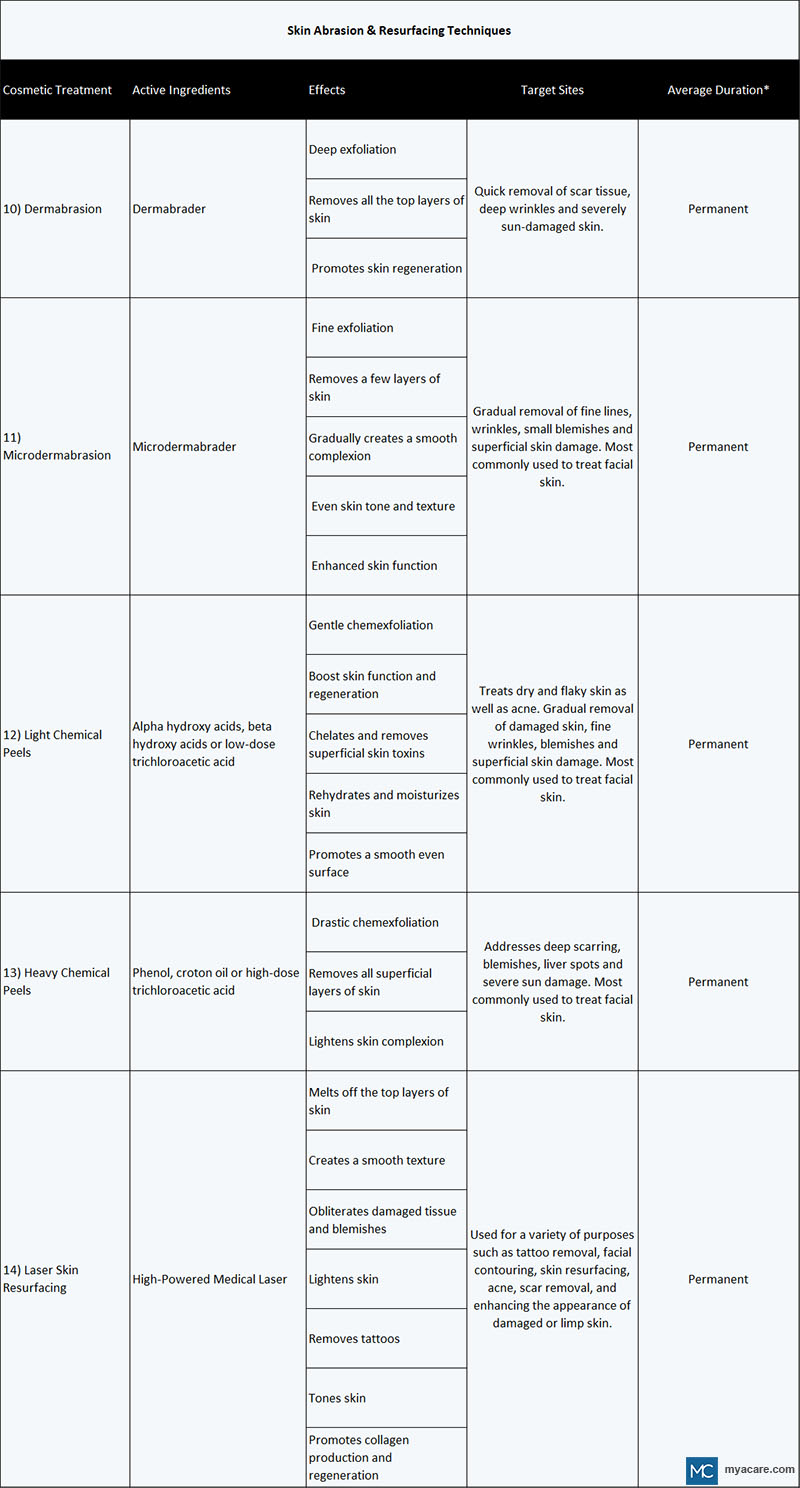
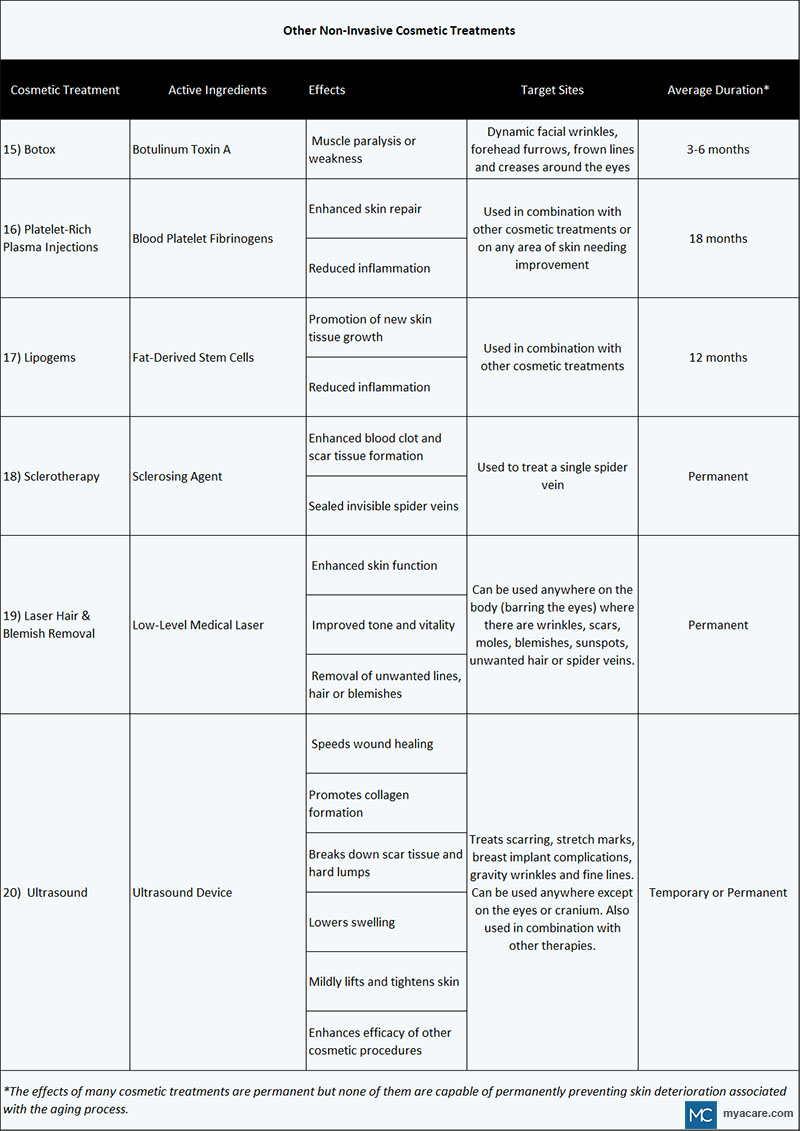
Sources:
- [32] https://pubmed.ncbi.nlm.nih.gov/29064980/
- [33] https://www.ncbi.nlm.nih.gov/pmc/articles/PMC6371733/
- [34] https://onlinelibrary.wiley.com/doi/full/10.1111/ajd.13273
- [35] https://www.ncbi.nlm.nih.gov/pmc/articles/PMC7028373/
- [36] https://link.springer.com/referenceworkentry/10.1007%2F978-3-319-20253-2_34-1
- [37] https://www.ncbi.nlm.nih.gov/pmc/articles/PMC2840909/
- [38] https://www.ncbi.nlm.nih.gov/pmc/articles/PMC4173863/
- [39] https://ir.uiowa.edu/cgi/viewcontent.cgi?article=7268&context=etd
- [40] https://www.ncbi.nlm.nih.gov/pmc/articles/PMC4754297/
- [41] https://www.ncbi.nlm.nih.gov/pmc/articles/PMC5013587/
- [42] https://www.restylane.com/en/REFRESH
- [43] https://www.harpersbazaar.com/uk/beauty/beauty-shows-trends/a22622536/non-surgical-nose-jobs/
- [44] https://www.ncbi.nlm.nih.gov/pmc/articles/PMC2544360/
- [45] https://www.healthline.com/health/perlane
- [46] https://www.accessdata.fda.gov/cdrh_docs/pdf4/p040024s006c.pdf
- [47] https://www.jjrothmd.com/blog/no-more-macrolane-for-breast-augmentation/
- [48] https://pubmed.ncbi.nlm.nih.gov/24507861/
- [49] https://parjournal.net/article/view/1347/839
- [50] https://www.drugs.com/juvederm.html
- [51] https://www.ncbi.nlm.nih.gov/pmc/articles/PMC3739705/
- [52] https://www.ncbi.nlm.nih.gov/pmc/articles/PMC5044990/
- [53] https://www.scielo.br/scielo.php?script=sci_arttext&pid=S0100-39842012000300014
- [54] https://www.ncbi.nlm.nih.gov/pmc/articles/PMC4533115/
- [55] https://www.ncbi.nlm.nih.gov/pmc/articles/PMC5044990/
- [56] https://www.researchgate.net/publication/8086999_CosmoDermCosmoPlast_Human_Bioengineered_Collagen_for_the_Aging_Face
- [57] https://www.webmd.com/vitamins/ai/ingredientmono-977/alpha-hydroxy-acids-ahas
- [58] https://www.asds.net/skin-experts/skin-treatments/injectables/injectable-poly-l-lactic-acid
- [59] https://www.meliorclinics.co.uk/treatments/sculptra/
- [60] https://parjournal.net/article/view/3169
- [61] https://www.ncbi.nlm.nih.gov/pmc/articles/PMC2544361/
- [62] https://www.ncbi.nlm.nih.gov/pmc/articles/PMC4295857/
- [63] https://www.healthline.com/health/radiesse
- [64] https://www.asds.net/skin-experts/skin-treatments/injectables/injectable-polymethylmethacrylate-bovine-collagen-filler
- [65] https://www.plasticsurgery.org/cosmetic-procedures/dermal-fillers/types
- [66] https://www.ncbi.nlm.nih.gov/books/NBK507871/
- [67] https://pubmed.ncbi.nlm.nih.gov/12814336/
- [68] https://www.ncbi.nlm.nih.gov/pmc/articles/PMC1889074/pdf/procrsmed00368-0092.pdf/?tool=EBI
- [69] https://www.ncbi.nlm.nih.gov/books/NBK535383/
- [70] https://pubmed.ncbi.nlm.nih.gov/17083587/
- [71] https://www.plasticsurgery.org/cosmetic-procedures/chemical-peel
- [72] https://www.americanboardcosmeticsurgery.org/procedure-learning-center/non-surgical/skin-resurfacing-guide/
- [73] https://www.ncbi.nlm.nih.gov/pmc/articles/PMC2921757/
- [74] https://www.ncbi.nlm.nih.gov/pmc/articles/PMC6017965/
- [75] https://www.ncbi.nlm.nih.gov/pmc/articles/PMC3047947/
- [76] https://www.ncbi.nlm.nih.gov/books/NBK547752/
- [77] https://www.plasticsurgery.org/cosmetic-procedures/laser-skin-resurfacing
- [78] https://www.ncbi.nlm.nih.gov/pmc/articles/PMC7118506/
- [79] https://www.ncbi.nlm.nih.gov/books/NBK557474/
- [80] https://www.ucsfhealth.org/treatments/ablative-laser-resurfacing
- [81] https://www.ncbi.nlm.nih.gov/pmc/articles/PMC3580982/
- [82] https://www.ncbi.nlm.nih.gov/pmc/articles/PMC4155739/
- [83] https://www.ncbi.nlm.nih.gov/books/NBK532248/
- [84] https://www.webmd.com/beauty/laser-skin-resurfacing#1
- [85] https://www.ncbi.nlm.nih.gov/pmc/articles/PMC3580977/
- [86] https://baaps.org.uk/patients/procedures/4/botulinum_toxin_injections
- [87] https://www.researchgate.net/publication/260429004_Safety_of_Botulinum_Toxin_A_in_Aesthetic_Treatments_A_Systematic_Review_of_Clinical_Studies
- [88] https://www.medicalnewstoday.com/articles/158647
- [89] https://www.accessdata.fda.gov/drugsatfda_docs/label/2011/103000s5236lbl.pdf
- [90] https://aestheticsjournal.com/feature/prp-in-facial-aesthetics
- [91] https://www.plasticsurgery.org/news/press-releases/platelet-rich-plasma-for-cosmetic-facial-procedures-promising-results-but-evidence-has-limitations
- [92] https://orthoinfo.aaos.org/en/treatment/platelet-rich-plasma-prp
- [93] https://www.medicalnewstoday.com/articles/320107
- [94] https://pubmed.ncbi.nlm.nih.gov/31280855/
- [95] https://academic.oup.com/asj/article/37/3/353/2520822
- [96] https://www.healthline.com/health/beauty-skin-care/microneedling-with-prp
- [97] https://www.hss.edu/condition-list_prp-injections.asp
- [98] https://prpinjectionmd.com/prp-injection-contraindications/
- [99] https://www.mayoclinic.org/tests-procedures/bone-marrow-transplant/in-depth/stem-cells/art-20048117
- [100] https://www.theregenerativeclinic.co.uk/evidence/adipose-tissue-and-mesenchymal-stem-cells-state-of-the-art-and-lipogems-technology-development/
- [101] https://pubmed.ncbi.nlm.nih.gov/25168156/
- [102] https://www.nature.com/articles/s41598-019-54797-5
- [103] https://www.ncbi.nlm.nih.gov/pmc/articles/PMC5799755/
- [104] https://www.theregenerativeclinic.co.uk/lipogems/the-procedure/
- [105] https://www.bostonstemcell.com/how-long-do-stem-cell-injections-last/
- [106] https://www.ncbi.nlm.nih.gov/pmc/articles/PMC3070641/
- [107] https://www.fda.gov/consumers/consumer-updates/fda-warns-about-stem-cell-therapies
- [108] https://www.webmd.com/skin-problems-and-treatments/surgery-for-varicose-veins#1
- [109] https://www.plasticsurgery.org/cosmetic-procedures/spider-vein-treatment/procedure
- [110] https://pubmed.ncbi.nlm.nih.gov/27738241/
- [111] https://journals.lww.com/dermatologicsurgery/Citation/2004/09000/Polidocanol_or_Chromated_Glycerin_for.26.aspx
- [112] https://pubmed.ncbi.nlm.nih.gov/20891036/
- [113] https://emedicine.medscape.com/article/1271091-treatment
- [114] https://www.ncbi.nlm.nih.gov/pmc/articles/PMC3036277/
- [115] https://www.unmc.edu/surgery/divisions/plasticsurgery/cosmetic/spider-veins.html
- [116] https://www.ncbi.nlm.nih.gov/pmc/articles/PMC4795889/
- [117] https://dermnetnz.org/topics/lasers-in-dermatology/
- [118] https://www.ncbi.nlm.nih.gov/books/NBK507861/
- [119] https://www.mayoclinic.org/tests-procedures/laser-resurfacing/about/pac-20385114
- [120] https://health.clevelandclinic.org/how-ultrasound-skin-tightening-can-firm-lift-your-face/
- [121] https://www.healthline.com/health/hifu-for-face#summary
- [122] https://burnstrauma.biomedcentral.com/articles/10.1186/s41038-018-0141-0
- [123] https://www.ncbi.nlm.nih.gov/books/NBK507861/
- [124] https://europepmc.org/article/med/27128245
- [125] https://espritcosmetic.com/procedures/breast-augmentation-portland/aspen-recovery-system/
- [126] https://bmcophthalmol.biomedcentral.com/articles/10.1186/s12886-018-0891-2
Disclaimer: Please note that Mya Care does not provide medical advice, diagnosis, or treatment. The information provided is not intended to replace the care or advice of a qualified health care professional. The views expressed are personal views of the author and do not necessarily reflect the opinion of Mya Care. Always consult your doctor for all diagnoses, treatments, and cures for any diseases or conditions, as well as before changing your health care regimen. Do not reproduce, copy, reformat, publish, distribute, upload, post, transmit, transfer in any manner or sell any of the materials in this blog without prior written permission from myacare.com.


